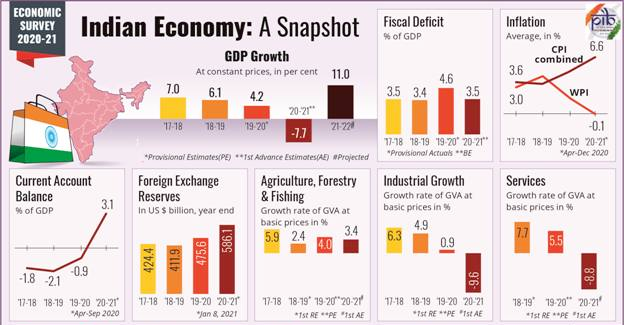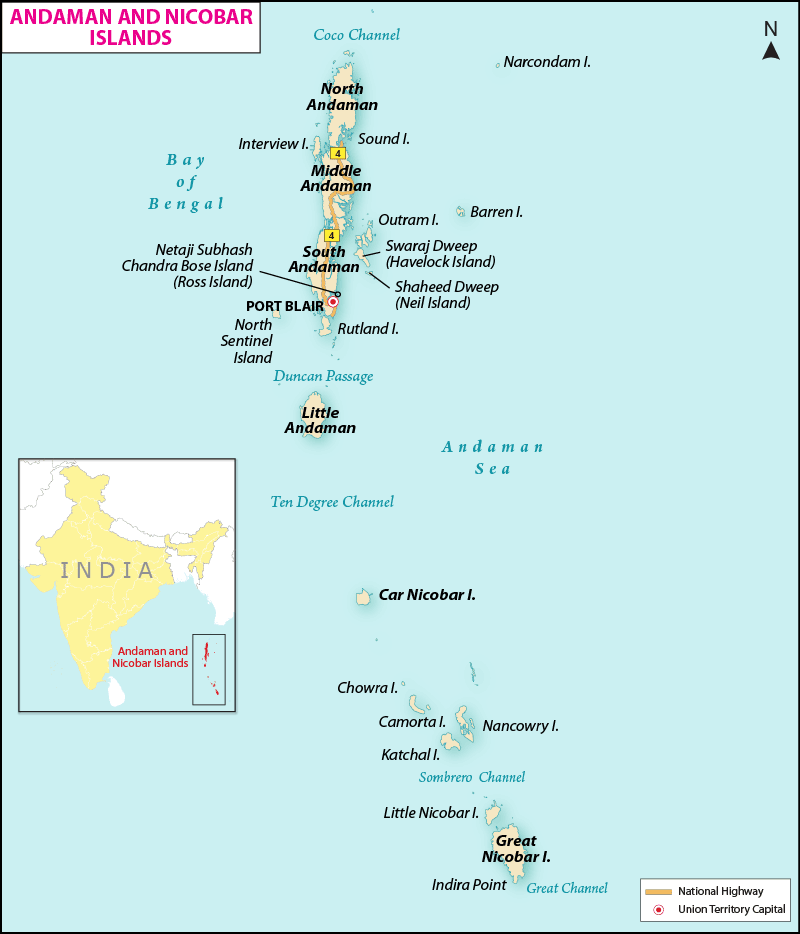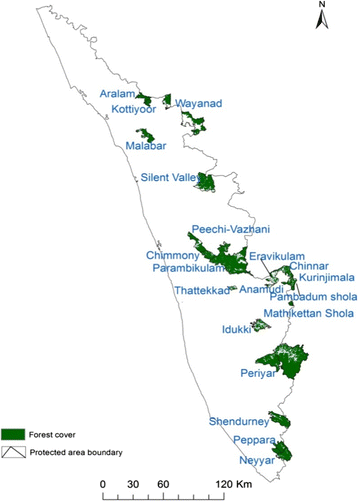Indian Economy
Highlights of Economic Survey 2021
Why in News
Recently, the Union Minister of Finance presented the Economic Survey that details the state of the economy ahead of the government's budget for the fiscal year beginning 1st April, 2021.
- The foundational theme of the survey is "Saving Lives and Livelihoods".
Economic Survey
- The Economic Survey of India is an annual document released by the Ministry of Finance, Government of India.
- It contains the most authoritative and updated source of data on India’s economy.
- It is a report that the government presents on the state of the economy in the past one year, the key challenges it anticipates, and their possible solutions.
- The Economic Survey document is prepared by the Economics Division of the Department of Economic Affairs (DEA) under the guidance of the Chief Economic Advisor.
- It is usually presented a day before the Union Budget is presented in the Parliament.
- The first Economic Survey in India was presented in the year 1950-51. Up to 1964, it was presented along with the Union Budget. From 1964 onwards, it has been delinked from the Budget.
Key Points
- Indian Economy and Covid:
- Strategy to face the pandemic:
- Response stemmed from the humane principle that:
- Human lives lost cannot be brought back.
- Gross Domestic Product (GDP) growth will recover from the temporary shock caused by the Covid-19 pandemic.
- India’s policy response also derived from extensive research on epidemiology, especially that looked at Spanish Flu of 1918.
- One of the key insights was that pandemic spreads faster in higher and denser population and intensity of lockdown matters most at the beginning of the pandemic.
- Response stemmed from the humane principle that:
- Four Pillar Strategy:
- India adopted a unique four-pillar strategy of containment, fiscal, financial, and long-term structural reforms.
- Calibrated fiscal and monetary support was provided given the evolving economic situation.
- A favorable monetary policy ensured abundant liquidity and immediate relief to debtors via temporary moratoria, while facilitating monetary policy transmission.
- Cushioning the vulnerable in the lockdown and boosting consumption and investment while unlocking, mindful of fiscal repercussions and entailing debt sustainability.
- Covid pandemic affected both demand and supply:
- India was the only country to announce structural reforms to expand supply in the medium-long term and avoid long-term damage to productive capacities.
- The Rs. 1.46-lakh crore Production Linked Incentive (PLI) scheme is expected to make India an integral part of the global supply chain and create huge employment opportunities
- Demand-side measures have been announced in a calibrated manner.
- A public investment programme centered around the National Infrastructure Pipeline to accelerate the demand push and further the recovery.
- India was the only country to announce structural reforms to expand supply in the medium-long term and avoid long-term damage to productive capacities.
- Strategy to face the pandemic:
- Economic Recovery:
- V-shaped Economic Recovery after Lockdown:
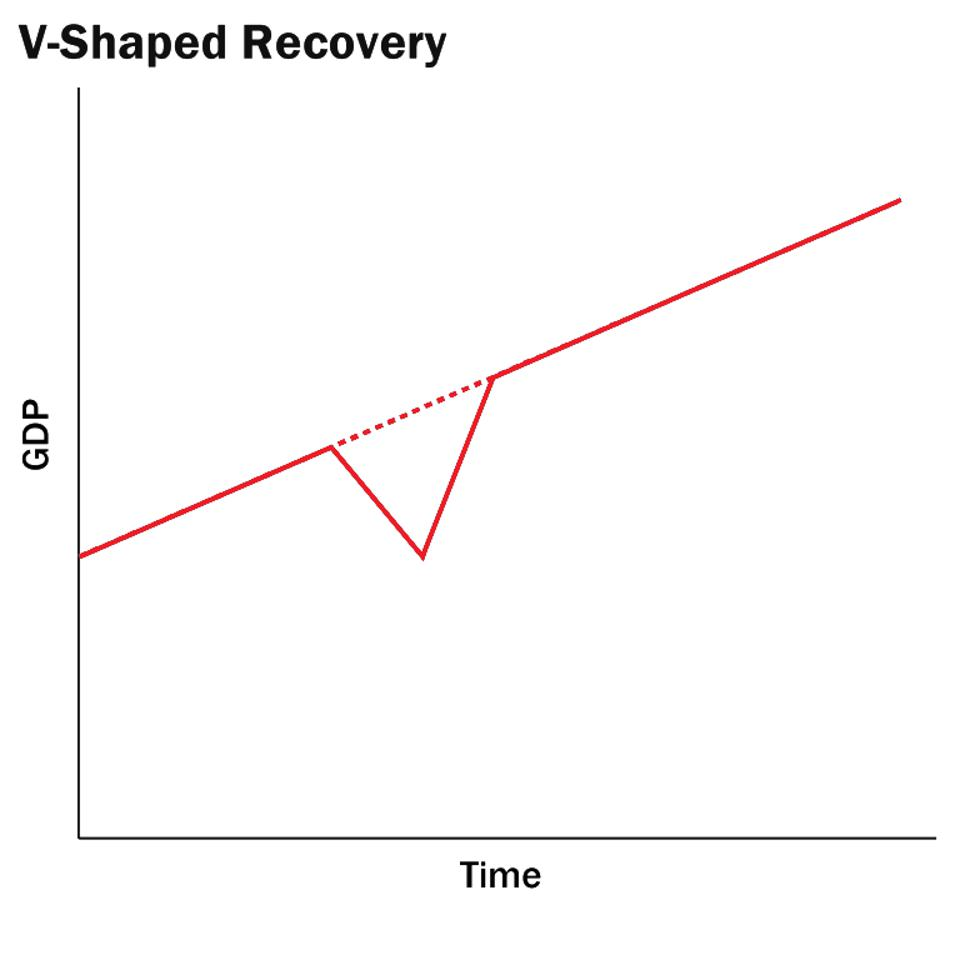
- Starting July 2020, a resilient V-shaped recovery is underway.
- V-shaped recovery is a type of economic recession and recovery that resembles a "V" shape in charting.
- Specifically, a V-shaped recovery represents the shape of a chart of economic measures economists create when examining recessions and recoveries.
- A V-shaped recovery is characterized by a quick and sustained recovery in measures of economic performance after a sharp economic decline.
- Reasons:
- It is supported by the initiation of a mega vaccination drive with hopes of a robust recovery in the services sector and prospects for robust growth in consumption and investment.
- V-shaped recovery is due to resurgence in high frequency indicators such as power demand, rail freight, E-Way bills, Goods and Services Tax (GST) collection, steel consumption, etc.
- The fundamentals of the economy remain strong as gradual scaling back of lockdowns along with the support of Aatmanirbhar Bharat Mission have placed the economy firmly on the path of revival.
- Significance:
- This path would entail a growth in real Gross Domestic Product (GDP) by 2.4% over the absolute level of 2019-20 - implying that the economy would take two years to reach and go past the pre-pandemic level.
- GDP’s Estimation:
- India’s real GDP to record a growth of 11% in 2021-22 and nominal GDP by 15.4% - the highest since independence.
- These projections are in line with International Monetary Fund estimates.
- India’s GDP is estimated to contract by 7.7% in the Financial Year (FY) 2020-21, composed of a sharp 15.7% decline in the first half and a modest 0.1% fall in the second half.
- Sector-wise, agriculture has remained the silver lining while contact-based services, manufacturing, construction were hit hardest, and have been recovering steadily.
- The external sector provided an effective cushion to growth with India recording a Current Account Surplus of 3.1% of GDP in the first half of FY 2020-21.
- India’s real GDP to record a growth of 11% in 2021-22 and nominal GDP by 15.4% - the highest since independence.
- Foreign Investment:
- Net Foreign Direct Investment (FDI) inflows of USD 27.5 billion during April-October, 2020 - 14.8% higher as compared to the first seven months of FY 2019-20.
- Net Foreign Portfolio Investment (FPI) Inflows recorded an all-time monthly high of 9.8 Billion Dollars in November 2020.
- Debt Sustainability and Growth:
- Growth leads to debt sustainability in the Indian context but not necessarily vice-versa.
- Debt sustainability depends on the ‘Interest Rate Growth Rate Differential’ (IRGD), i.e., the difference between the interest rate and the growth rate.
- Negative IRGD in India – not due to lower interest rates but much higher growth rates – prompts a debate on fiscal policy, especially during growth slowdowns and economic crises.
- Fiscal policy that provides an impetus to growth will lead to lower debt-to-GDP ratio.
- Given India’s growth potential, debt sustainability is unlikely to be a problem even in the worst scenarios.
- Desirable to use counter-cyclical fiscal policy to enable growth during economic downturns.
- Counter-cyclical fiscal policy refers to the steps taken by the government that go against the direction of the economic or business cycle.
- Thus, in a recession or slowdown, the government increases expenditure and reduces taxes to create a demand that can drive an economic boom.
- V-shaped Economic Recovery after Lockdown:
- Services Sector:
- About:
- The services sector accounts for over 54% of India’s Gross Value Added (GVA) and nearly four-fifths of total Foreign Direct Investments (FDI) inflow into India.
- Services sector accounts for 48% of total exports, outperforming goods exports in recent years.
- Key indicators such as Services Purchasing Managers’ Index, rail freight traffic, and port traffic, are all displaying a V-shaped recovery after a sharp decline during the lockdown.
- Start Up: The Indian start-up ecosystem has been progressing well amidst the Covid-19 pandemic, being home to 38 unicorns - adding a record number of 12 start-ups to the unicorn list last year.
- Space Sector: India’s space sector has grown exponentially in the past six decades. Space ecosystem is undergoing several policy reforms to engage private players and attract innovation and investment.
- About:
- Agriculture:
- Growth:
- The Agriculture and Allied activities clocked a growth of 3.4%.
- As per the Provisional Estimates of National Income released by Central Statistical Organization in May, 2020, the share of Agriculture and Allied Sectors in Gross Value Added (GVA) of the country at current prices is 17.8% for the year 2019-20.
- Export:
- In 2019-20, the major agricultural and allied export destinations were the USA, Saudi Arabia, Iran, Nepal and Bangladesh.
- The top agriculture and related products exported from India were marine products, basmati rice, buffalo meat, spices, non-basmati rice, cotton raw, oil meals, sugar, castor oil and tea.
- Livestock:
- The contribution of Livestock in total agriculture and allied sector GVA (at Constant Prices) has increased from 24.32% (2014-15) to 28.63% (2018-19).
- Food Processing Industries (FPI):
- During the last 5 years ending 2018-19, FPI sector has been growing at an Average Annual Growth Rate (AAGR) of around 9.99% as compared to around 3.12% in Agriculture and 8.25% in Manufacturing at 2011-12 prices.
- Farm Laws:
- It strongly defended new farm laws, saying they herald a new era of market freedom which can go a long way in improving lives of small and marginal farmers in India.
- These legislations were designed "primarily" for the benefit of "small and marginal farmers", which constitute around 85% of the total number of farmers and are the biggest sufferer of the "regressive" Agricultural Produce Market Committee (APMC) -regulated market regime.
- Growth:
- Regulatory Forbearance:
- Regulatory forbearance for banks after the Global Financial Crisis involved relaxing the norms for restructuring assets, where restructured assets were no longer required to be classified as Non-Performing Assets (NPAs henceforth) and therefore did not require the levels of provisioning that NPAs attract.
- However, the survey points out that regulatory forbearance is an emergency medicine, not staple diet and suggests :
- Instead of continuing regulatory forbearance for years, policymakers should lay out thresholds of economic recovery at which such measures will be withdrawn.
- An Asset Quality Review exercise must be conducted by banks immediately after the forbearance is withdrawn.
- Legal infrastructure for the recovery of loans needs to be strengthened de facto.
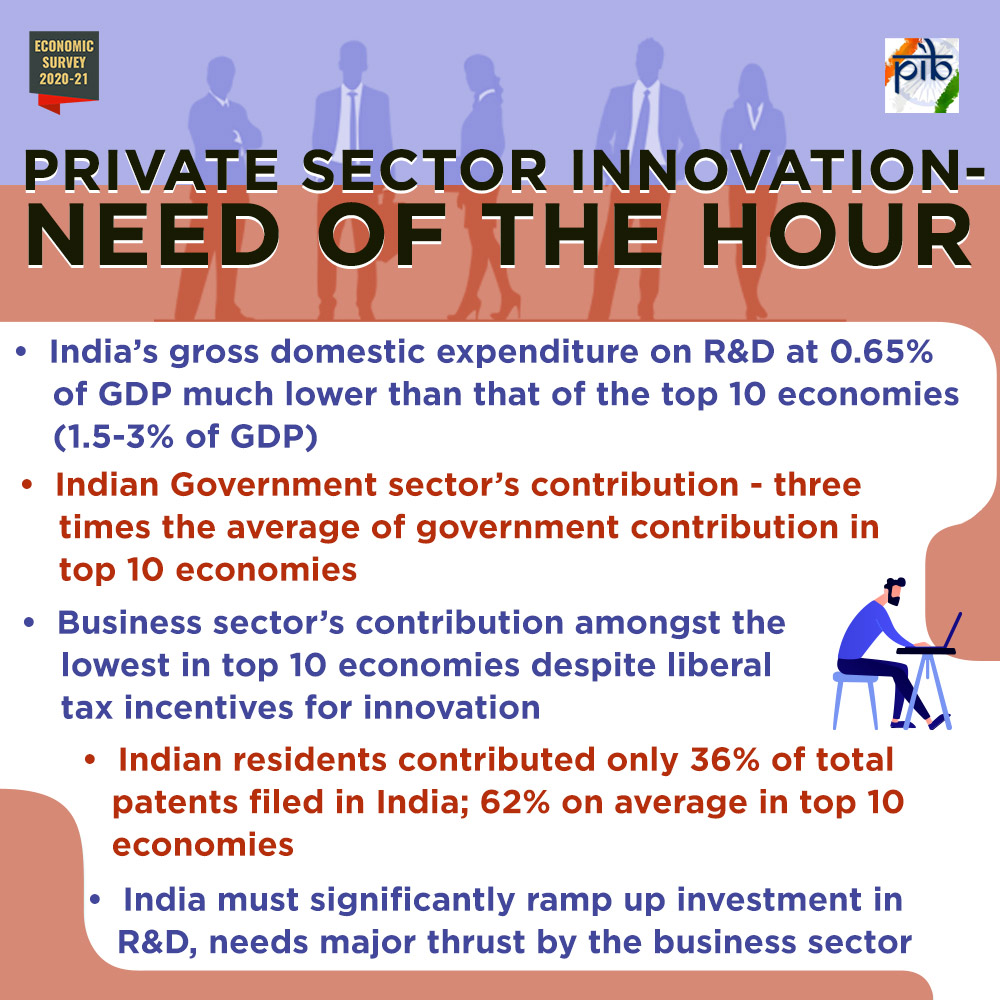
- To promote judgement amidst uncertainty, ex-post inquests must recognize the role of hindsight bias and not equate unfavourable outcomes to bad judgement or malafide intent.
- India and Innovation:
- India entered the top-50 innovating countries for the first time in 2020 since the inception of the Global Innovation Index in 2007, ranking first in Central and South Asia, and third amongst lower middle-income group economies
- India’s Gross Domestic Expenditure on Research and Development (GERD) is lowest amongst top ten economies.
- India’s aspiration must be to compete on innovation with the top ten economies.
- Process Reforms:
- The survey highlighted excessive regulation in the country.
- India over-regulates the economy resulting in regulations being ineffective even with relatively good compliance with process.
- The root cause of the problem of overregulation is an approach that attempts to account for every possible outcome. Increase in complexity of regulations, intended to reduce discretion, results in even more non-transparent discretion.
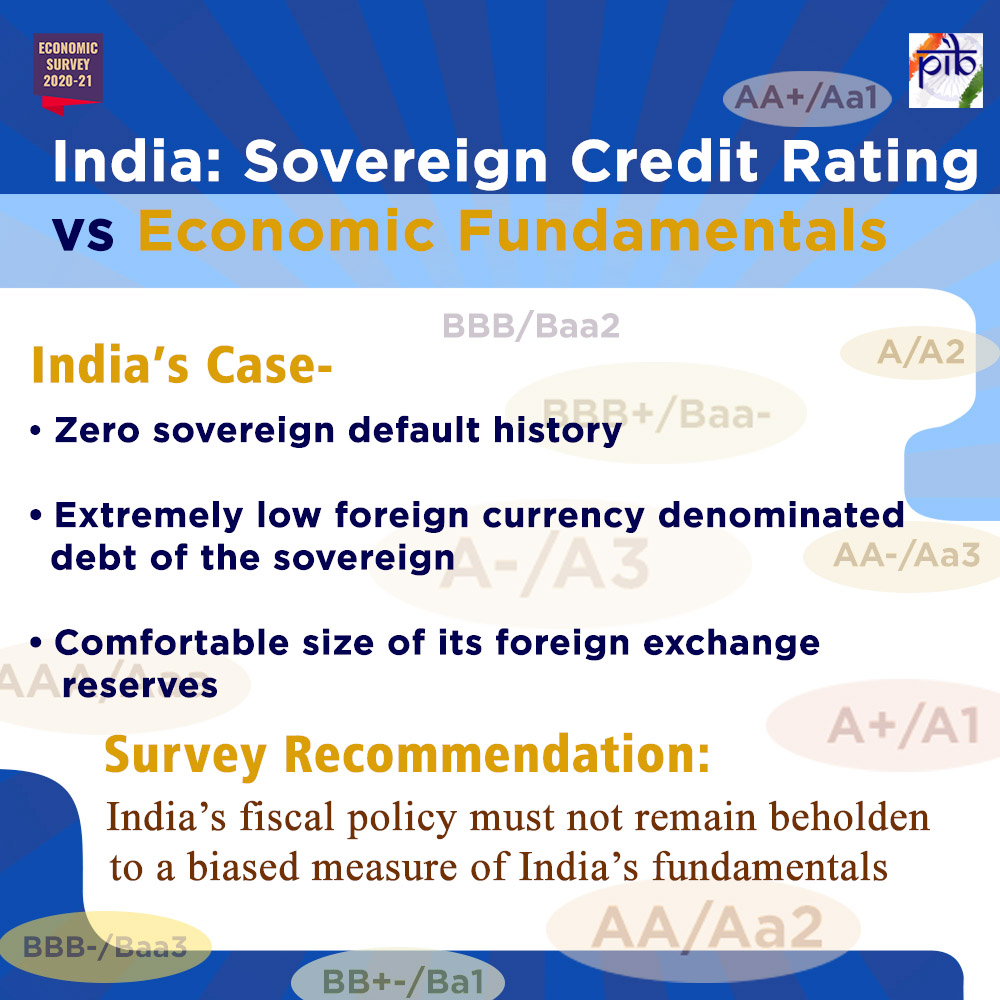
- The solution is to simplify regulations and invest in greater supervision which, by definition, implies greater discretion.
- India and Sovereign Credit Ratings:
- India's sovereign credit ratings do not reflect the economy's fundamentals and the global agencies should become more transparent and less subjective in their ratings.
- Defence Sector:
- The allocated capital budget for defence has been fully utilised since 2016-17, reversing the previous trends of surrender of funds.
- Healthcare:
- Pradhan Mantri Jan Arogya Yojana (PM-JAY):
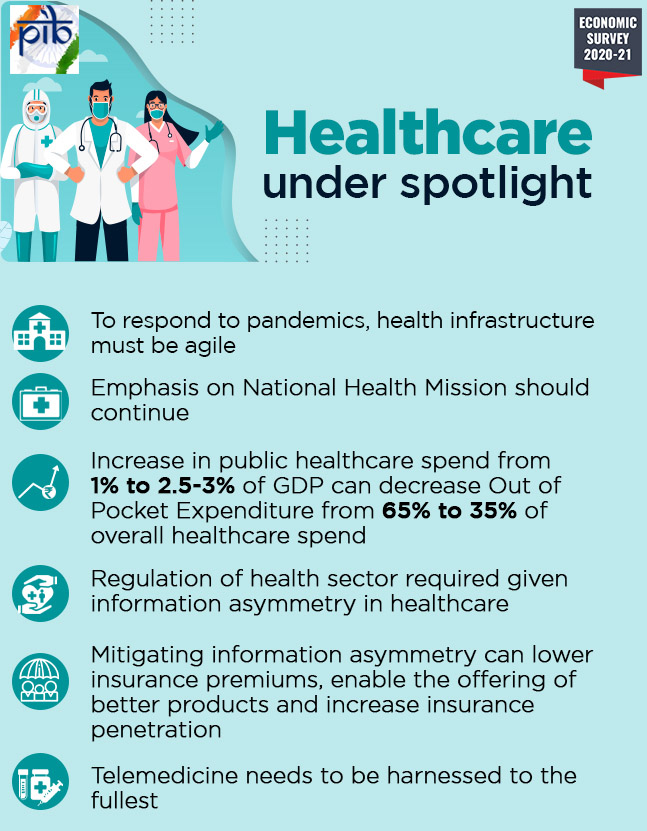
- PM-JAY contributed to improvement in many health outcomes in States that implemented the ambitious programme the Centre had launched more than two years ago to provide healthcare access to most vulnerable sections.
- National Health Mission (NHM):
- NHM played a critical role in mitigating inequity as the access of the poorest to pre-natal/post-natal care and institutional deliveries increased significantly.
- The scheme should be given prominence under Ayushman Bharat.
- Government Spending:
- An increase in government spending on the healthcare sector – from the current 1% to 2.5-3% of GDP – as envisaged in the National Health Policy 2017 could reduce out-of-pocket expenditures.
- Pradhan Mantri Jan Arogya Yojana (PM-JAY):
- Education:
- Literacy:
- India has attained a literacy level of almost 96% at the elementary school level.
- As per National Sample Survey (NSS), the literacy rate of persons of age 7 years and above at the All India level stood at 77.7% but the differences in literacy rate attainment among social-religious groups, as well as gender still persists.
- Female literacy remained below the national average among social groups of SC, ST, OBC, including religious groups of Hinduism and Islam.
- Rural Enrolment:
- The percentage of enrolled children from government and private schools owning a smartphone increased enormously from 36.5% in 2018 to 61.8% in 2020 in rural India.
- PM eVIDYA:
- PM eVIDYA is a comprehensive initiative to unify all efforts related to digital/online/on-air education to enable multi-mode and equitable access to education for students and teachers.
- Around 92 courses have started and 1.5 crore students are enrolled under Swayam Massive Open Online Courses (MOOCs) which are online courses relating to the National Institute of Open Schooling.
- PRAGYATA:
- PRAGYATA guidelines on digital education have been developed with a focus on online/blended/digital education for students who are presently at home due to closure of schools.
- MANODARPAN:
- The MANODARPAN initiative for psychological support has been included in Atmanirbhar Bharat Abhiyan.
- Literacy:
- Vocational Courses and Skill Development:
- Vocational courses will be introduced phase-wise in schools for classes 9 to 12 to expose students to skill development avenues, as part of the Centre's flagship skilling scheme Pradhan Mantri Kaushal Vikas Yojana 3.0.
- Merely 2.4% of India's workforce in the age group of 15-59 years have received formal vocational or technical training, while another 8.9% obtained training through informal sources.
- Out of the 8.9% workforce who received non-formal training, the largest chunk is contributed by on-the-job training (3.3%), followed by self-learning (2.5%) and hereditary sources (2.1%) and other sources (1%).
- Among those who received formal training, the most opted training course is IT-ITeS among both males and females.
- The Unified Skill Regulator- National Council for Vocational Education and Training (NCVET) was operationalized recently.
- Vocational courses will be introduced phase-wise in schools for classes 9 to 12 to expose students to skill development avenues, as part of the Centre's flagship skilling scheme Pradhan Mantri Kaushal Vikas Yojana 3.0.
- Bare Necessities:
- Bare Necessities Index (BNI) :
- Bare Necessities Index (BNI) based on the large annual household survey data can be constructed using suitable indicators and methodology at district level for all/targeted districts to assess the progress on access to bare necessities.
- The BNI summarises 26 indicators on five dimensions viz., water, sanitation, housing, micro-environment, and other facilities.
- Bare Necessities Index (BNI) based on the large annual household survey data can be constructed using suitable indicators and methodology at district level for all/targeted districts to assess the progress on access to bare necessities.
- Improvement in Bare Necessities:
- Bare necessities have improved across all States in the country in 2018 as compared to 2012.
- Increase in equity is noteworthy as the rich can access private options for public goods.
- Bare Necessities Index (BNI) :
- Sustainable Development and Climate Change:
- India has taken several proactive steps to mainstream the Sustainable Development Goals (SDGs) into the policies, schemes and programmes.
- Voluntary National Review (VNR) presented to the United Nations High-Level Political Forum (HLPF) on Sustainable Development.
- Localisation of SDGs is crucial to any strategy aimed at achieving the goals under the 2030 Agenda.
- Sustainable development remains core to the development strategy despite the unprecedented Covid-19 pandemic crisis.
- Eight National Missions under the National Action Plan on Climate Change (NAPCC) focussed on the objectives of adaptation, mitigation and preparedness on climate risks.
- Nationally Determined Contributions (NDC) states that finance is a critical enabler of climate change action.
- The International Solar Alliance (ISA) launched two new initiatives – ‘World Solar Bank’ and ‘One Sun One World One Grid Initiative’ – poised to bring about a solar energy revolution globally.
- India has taken several proactive steps to mainstream the Sustainable Development Goals (SDGs) into the policies, schemes and programmes.
- Social Infrastructure, Employment and Human Development:
- The combined (Centre and States) social sector expenditure as % of GDP has increased in 2020-21 compared to last year.
- India’s rank in Human development Index (HDI) 2019 was recorded at 131, out of a total 189 countries.
- Government’s incentive to boost employment through Aatmanirbhar Bharat Rozgar Yojana and rationalization and simplification of existing labour codes into 4 codes.
- Low level of female Labour Force Participation Rate (LFPR) in India:
- Females spending disproportionately more time on unpaid domestic and caregiving services to household members as compared to their male counterparts (Time Use Survey, 2019).
- Need to promote non-discriminatory practices at the workplace like pay and career progression, improve work incentives, including other medical and social security benefits for female workers.
- Inequality and Growth:
- Both inequality and per-capita income (growth) have similar relationships with socio-economic indicators in India, unlike in advanced economies.
- Economic growth has a greater impact on poverty alleviation than inequality.
- India must continue to focus on economic growth to lift the poor out of poverty. Redistribution in a developing economy is feasible only if the size of the economic pie grows.
Indian Economy
Increased Fiscal Deficit
Why in News
The government’s fiscal deficit has increased to Rs. 11.58 lakh crore or 145.5% of the Budget Estimate (BE) at the end of December 2020 (accounting for the first nine months of the year 2020-21) mainly on account of lower revenue realisation.
Key Points
- Fiscal Deficit Target Fixed for 2020-21: The Centre had pegged the fiscal deficit at Rs. 7.96 lakh crore or 3.5% of the Gross Domestic Product (GDP).
- Fiscal Deficit in 2019-2020: According to the data released by the Controller General of Accounts (CGA), the fiscal deficit at the end of December in the previous fiscal year was 132.4% of the BE of 2019-20.
- Reasons for High Fiscal Deficit:
- Lower Revenue Realisation:
- Because of disruptions in normal business activity following the coronavirus pandemic and lockdowns.
- Higher Expenditure:
- There has been a notable increase in revenue expenditure in food and public distribution and rural development which could be attributed to the government’s pandemic relief programs.
- Lower Revenue Realisation:
Fiscal Deficit
- The government describes fiscal deficit of India as “the excess of total disbursements from the Consolidated Fund of India, excluding repayment of the debt, over total receipts into the Fund (excluding the debt receipts) during a financial year”.
- In simple words, it is a shortfall in a government's income compared with its spending.
- The government that has a fiscal deficit is spending beyond its means.
- It is calculated as a percentage of Gross Domestic Product (GDP), or simply as total money spent in excess of income.
- In either case, the income figure includes only taxes and other revenues and excludes money borrowed to make up the shortfall.
- Formula:
- Fiscal Deficit = Total expenditure of the government (capital and revenue expenditure) – Total income of the government (Revenue receipts + recovery of loans + other receipts).
- Expenditure component: The government in its Budget allocates funds for several works, including payments of salaries, pensions, etc. (revenue expenditure) and creation of assets such as infrastructure, development, etc. (capital expenditure).
- Income component: The income component is made of two variables, revenue generated from taxes levied by the Centre and the income generated from non-tax variables.
- The taxable income consists of the amount generated from corporation tax, income tax, Customs duties, excise duties, GST, among others.
- Meanwhile, the non-taxable income comes from external grants, interest receipts, dividends and profits, receipts from Union Territories, among others.
- It is different from revenue deficit which is only related to revenue expenditure and revenue receipts of the government.
- The government meets the fiscal deficit by borrowing money. In a way, the total borrowing requirements of the government in a financial year is equal to the fiscal deficit in that year.
- A high fiscal deficit can also be good for the economy if the money spent goes into the creation of productive assets like highways, roads, ports and airports that boost economic growth and result in job creation.
- The Fiscal Responsibility and Budget Management Act, 2003 provides that the Centre should take appropriate measures to limit the fiscal deficit upto 3% of the GDP by 31st March, 2021.
- The NK Singh committee (set up in 2016) recommended that the government should target a fiscal deficit of 3% of the GDP in years up to 31st March, 2020, cut it to 2.8% in 2020-21 and to 2.5% by 2023.
- Fiscal Deficit = Total expenditure of the government (capital and revenue expenditure) – Total income of the government (Revenue receipts + recovery of loans + other receipts).
Controller General of Accounts
- It comes under the Department of Expenditure, Ministry of Finance.
- It is the Principal Accounting Adviser to the Government of India and is responsible for establishing and maintaining a technically sound Management Accounting System.
- The Office of CGA prepares monthly and annual analysis of expenditure, revenues, borrowings and various fiscal indicators for the Union Government.
Biodiversity & Environment
NITI Aayog’s Proposal for Little Andaman
Why in News
Recently, a plan named the Sustainable Development of Little Andaman Island Vision Document by NITI Aayog for the sustainable and holistic development of the 680 sq km, fragile Little Andaman Island in the Andaman and Nicobar island group has raised alarm among conservationists.
- Earlier in 2020, the Prime Minister declared that the Andaman and Nicobar islands will be developed as a "maritime and startup hub".
Key Points
- Purpose:
- To leverage the strategic location and natural features of the island.
- The islands are critical for India's security because of their strategic location in the Indian Ocean Region (IOR).
- Better infrastructure and connectivity will help India enhance its military and naval strength in the islands.
- To leverage the strategic location and natural features of the island.
- Plan:
- Building a new greenfield coastal city, that will be developed as a free trade zone and will compete with Singapore and Hong Kong.
- Three Zones: It has divided the development in three zones:
- Zone 1 :
- Spread over 102 sq km alongside the east coast of Little Andaman.
- It would be the monetary district and medi metropolis and can embody an aerocity, and a tourism and hospital district.
- Zone 2:
- Spread over 85 sq km of pristine forest.
- It is the leisure zone, can have a movie metropolis, a residential district and a tourism Special Economic Zone (SEZ).
- Zone 3 :
- Spread over 52 sq km of pristine forest.
- It shall be a nature zone, additional categorized into three districts: an unique forest resort, a nature therapeutic district and a nature retreat, all on the western coast.
- Zone 1 :
- Transport Development:
- A worldwide airport able to deal with all varieties of plane is central to the plan as a global airport is vital for growth.
- The solely jetty on the island might be expanded and a marina might be developed subsequent to the tourist entertainment district.
- A 100 km greenfield ring highway might be constructed parallel to the shoreline from east to west and might be supplemented with a mass fast transit community with stations at common intervals.
- Bottlenecks:
- Lack of fine connectivity with Indian mainland and world cities.
- Fragile biodiversity and natural ecosystems and certain Supreme Court notifications that pose an obstacle to development.
- Another key issue is the presence of indigenous tribes and concerns for their welfare.
- 95% of Little Andaman is covered in forest, a big part of it the pristine evergreen sort. Some 640 sq km of the island is Reserve Forest under the Indian Forest Act 1927, and almost 450 sq km is protected because of the Onge Tribal Reserve, creating a singular and uncommon socio-ecological-historical complex of high importance.
- Solution Proposed in the Plan:
- The proposal wants 240 sq km (35%) of this land and the options are:
- De-reserve 32% of the reserved forest and de-notify 138 sq km or 31% of the tribal reserve.
- If the tribals develop into an obstacle, the proposal says that they can be relocated to other parts of the island.
- The proposal wants 240 sq km (35%) of this land and the options are:
- Flaws in the Proposal:
- It talks of conservation of nationwide park/wildlife sanctuary on Little Andaman when none exist right here and it has no mention of the geological vulnerability of the place, which was amongst the worst-affected within the earthquake-tsunami combination in 2004.
- The waves hit Little Andaman so hard that the breakwater there was not just breached, it was physically displaced and it’s orientation changed. Ships couldn’t berth for weeks thereafter.
- The plan has no financial details, no budgeting, or inventorisation of forests and ecological wealth and no particulars of any impact assessment.
- The nature resort proposed at West Bay on the western coast is to have theme resorts, floating/underwater resorts, seaside inns, and high-end residential villas.
- It is today a secluded and difficult to reach part and one of the most vital nesting sites of the Giant Leatherback sea turtle.
- It talks of conservation of nationwide park/wildlife sanctuary on Little Andaman when none exist right here and it has no mention of the geological vulnerability of the place, which was amongst the worst-affected within the earthquake-tsunami combination in 2004.
- Forest Department’s Concern:
- In a note, Divisional Forest Officer, Little Andaman, raised severe considerations about this proposal on grounds of ecological fragility, indigenous rights and vulnerability to earthquakes and tsunamis.
- It mentioned that such a large diversion of forest land would cause environmental loss leading to irreversible damage.
- Habitats of various wild animals will be affected.
- The proposal couldn’t even be assessed as a result of there being no environment impact assessment report and neither had there been any detailed site layout plans for the proposed diversion.
Little Andaman Island
- About:
- This island is part of the Little Andaman Group (Little Andaman is the counterpart of Great Andamans). This island is the fourth largest island in Andamans.
- It is famous by the name of its main village and the largest settlement –Hut Bay (rarely known by its other name Kwate-tu-kwage).
- Tribes:
- At a distance of about 120 Kilometers by sea from the capital town of Port Blair, this island has become a tribal reserve from sometime near to 1957.
- This is considered home to the Onge Tribes, even though there are multilingual settlers of Bengali, Tamil, Telugu, and Ranchi communities.
- Location and Transport:
- Lying at the southern end of the archipelago, Hut Bay Jetty is the only harbor for ships or boats coming into this island from the capital town –Port Blair.
- Little Andamans is less explored due to the limited mode of connection with the capital town of Port Blair.
Governance
Bharat Parv 2021
Why in News
The annual event Bharat Parv was celebrated from 26th to 31st January, 2021 on a virtual platform created by the Ministry of Tourism.
- On the occasion, the Ministry dedicated three virtual pavilions - Dekho Apna Desh, Statue of Unity & Incredible India.
Key Points
- About the Bharat Parv:
- It envisages generating patriotic fervor and showcases the rich and varied cultural diversity of the country. This event celebrates the “Essence of India”.
- The Ministry of Tourism organizes Bharat Parv every year since 2016 in front of the ramparts of the Red Fort on the occasion of Republic Day Celebrations from 26th to 31st January.
- Bharat Parv 2021 showcased many pavilions of Central Ministries, State Theme Pavilions, Handicrafts, Folk performances from various states and UTs etc.
- ‘Dekho Apna Desh’ Campaign:
- It was launched by the Ministry of Tourism in 2020.
- It is an initiative to encourage the citizens to travel widely within the country and explore the wonders of India thus enabling the development of Domestic Tourism tourist facilities and infrastructure in tourism spots in the country.
- The Ministry has also organised a series of webinars on various cities, states, cultures, heritage, wildlife, adventure, etc.
- Statue of Unity:
- It is the Sardar Vallabhbhai Patel monument in the Narmada district of Gujarat.
- The Statue of Unity, designed by the Indian sculptor Ram V. Sutar is the world’s tallest statue, with a height of 182 metres.
- Statue of Unity pavilion also exhibited the idea of ‘Ek Bharat Shreshtha Bharat (EBSB)’ which aims to:
- Enhance interaction & promote mutual understanding between people of different States/UTs through the concept of State/UT pairing.
- Promote a sustained and structured cultural connect in the areas of language learning, culture, traditions & music, tourism & cuisine, sports and sharing of best practices, etc.
- Incredible India Pavilion:
- It comprised information on UNESCO World Heritage Sites.
- India has 38 world heritage sites, including 30 cultural properties, 7 natural properties and 1 mixed site. The latest one included is Jaipur city, Rajasthan.
Important Facts For Prelims
Periyar Tiger Reserve
Why in News
For the first time in the country, the Periyar Tiger Reserve (PTR) in Kerala has taken up training of a tiger cub to equip it to naturally hunt in the forest environment.
Key Points
- Location:
- It falls in the districts of Idukki and Pathanamthitta in Kerala (saddled in the southern region of Western Ghats).
- Formation:
- Declared a Sanctuary during 1950 and declared as Tiger Reserve during 1978. It gets its name from the River Periyar which has its origin deep inside the reserve.
- Drainage:
- The major rivers through the reserve are Mullayar and Periyar.
- Flora:
- The sanctuary comprises tropical evergreen, semi evergreen, moist deciduous forests and grasslands.
- About 1966 species of flowering plants grow in the sanctuary.
- Of this about 516 are endemic to the Western Ghats.
- The sanctuary is a repository of medicinal plants numbering to about 300.
- Some are endemic to the region like Syzygium periyarensis (a tree), Habenaria periyarensis (an orchid) and Mucuna pruriense thekkadiensis (a climber) etc.
- Fauna:
- Mammals: Tiger, Elephant, Lion-tailed macaque, Nilgiri Tahr etc.
- Birds: Darters, Cormorants, Kingfishers, the great Malabar Hornbill and racket-tailed Drongos.
- Reptiles: Monitor Lizards, Python, King Cobra etc.
- Tribals:
- There are six tribal communities nestled inside the reserve such as Mannans, Paliyans, Malayarayans, Mala Pandarams, Uralis and Ulladans.
- Protected Areas in Kerala:

